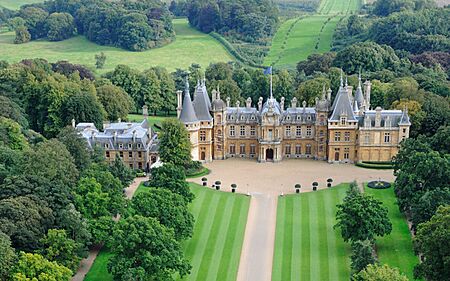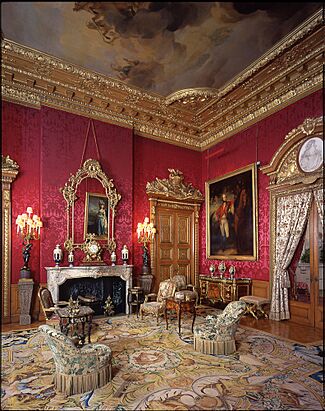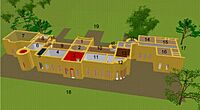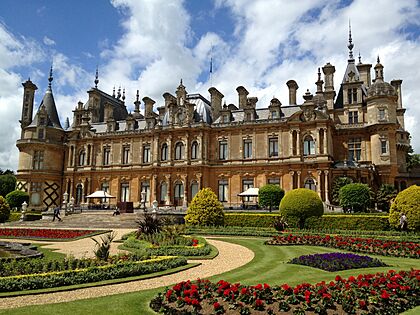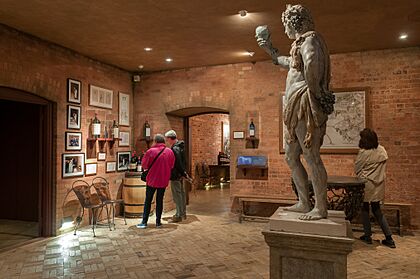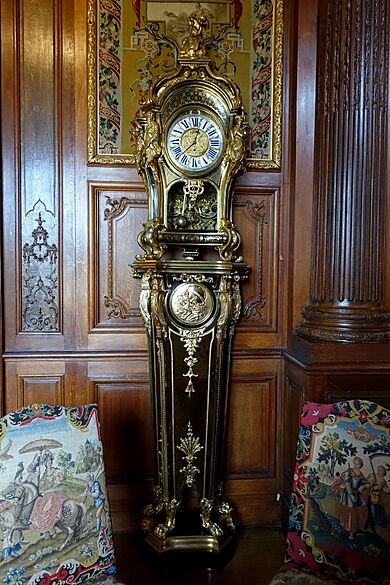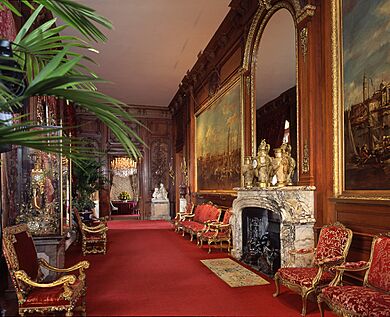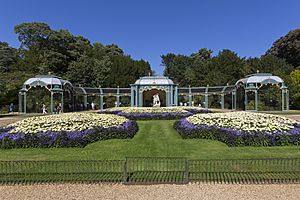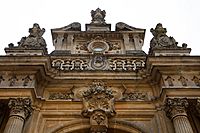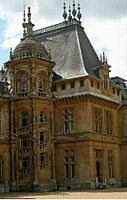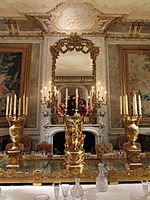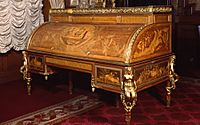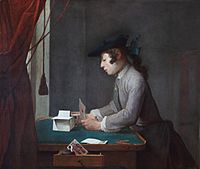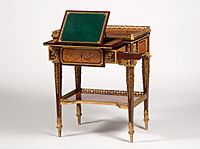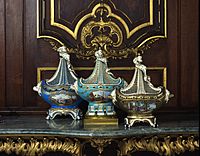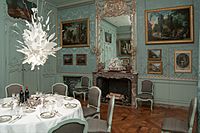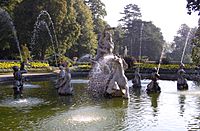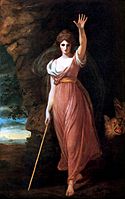Waddesdon Manor facts for kids
Quick facts for kids Waddesdon Manor |
|
|---|---|
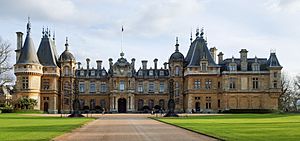
The north-facing entrance facade
|
|
| General information | |
| Architectural style | Neo-Renaissance |
| Classification | Museum |
| Address | Waddesdon, Aylesbury, Buckinghamshire, HP18 0JH |
| Country | United Kingdom |
| Coordinates | 51°50′32″N 0°56′16″W / 51.84222°N 0.93778°W OS grid SP 73310 16445 |
| Groundbreaking | 1874 (est.) |
| Construction started | 18 August 1877 |
| Completed | 1883 |
| Renovated | 1990–1997 |
| Client | Baron Ferdinand de Rothschild |
| Landlord | National Trust |
| Design and construction | |
| Architect | Hippolyte Destailleur |
|
Listed Building – Grade I
|
|
| Reference #: | 11117804 |
Waddesdon Manor is a grand country house in the village of Waddesdon, Buckinghamshire, England. It is owned by the National Trust but is managed by the Rothschild Foundation. This makes it a special partnership. The Manor is one of the National Trust's most popular sites, with over 463,000 people visiting in 2019.
The house was built between 1874 and 1889 for Baron Ferdinand de Rothschild. He wanted a weekend home that looked like a French château where he could entertain guests and display his amazing art collection.
Over the years, the Rothschild family added more treasures to the house. Today, it holds one of the most valuable art collections in the world. In 1957, the family gave the house and its contents to the National Trust so everyone could enjoy it. The Rothschild family still helps manage the house and continues to add to its collections.
Contents
History of the Manor
Building a Dream House (1874–1898)
In 1874, Baron Ferdinand de Rothschild bought the land for Waddesdon Manor. At the time, there was no house, park, or garden on the property. The main site was just a bare hill because the previous owner had sold all the timber.
Before building could start, the top of the hill had to be flattened. The first stone of the house was finally laid on August 18, 1877. The first party was held in 1880, even before the house was finished, with a spectacular fireworks display for the Baron's friends.
By 1883, the main house was ready. Baron Ferdinand hosted many important guests, including the future King Edward VII. Guests were amazed by the luxury and the excellent service from the 24 household staff. Even Queen Victoria visited in 1890, which was a rare honor. She loved the house and was fascinated by the new electric lights that were made to look like candles in the chandeliers.
A Family Legacy (1898–1957)
After Baron Ferdinand died in 1898, his sister, Alice de Rothschild, inherited the house. She saw Waddesdon as a tribute to her brother and worked hard to preserve it. She also added many important pieces to the collection, including royal French furniture and beautiful porcelain.
When Alice died in 1922, the manor passed to her great-nephew, James de Rothschild, and his wife, Dorothy. James added even more art and treasures from his father's collection in Paris.
During World War II, Waddesdon Manor became a safe home for children who were evacuated from the city of Croydon. This was the only time that children lived in the house.
A Gift to the Nation (1957–1997)
When James de Rothschild died in 1957, he left Waddesdon Manor and its contents to the National Trust. He wanted the house to be preserved for everyone to enjoy. The manor opened to the public in 1959.
His wife, Dorothy, continued to be very involved in managing the house. After her death in 1989, her nephew, Jacob Rothschild, took over her role. He started a major restoration project from 1990 to 1997 to repair the house and improve the experience for visitors. This included creating the famous Waddesdon Wine Cellars.
Waddesdon Today
The Rothschild Foundation, a family charity, continues to manage Waddesdon Manor. They are always working to preserve the house and its collections.
In 2003, a number of valuable gold boxes were stolen from the collection. Thanks to new security, the house is now safer. In 2021, one of the stolen items was found at an auction and returned to the manor.
Waddesdon also hosts special art exhibitions. They have displayed ancient art, like the Lod Mosaic from Israel, as well as works by modern artists. The Rothschild Foundation sometimes buys new art to add to the collection, like the painting Le Faiseur de Châteaux de Cartes (The House of Cards) by Jean-Baptiste-Siméon Chardin.
Architecture and Design
Baron Ferdinand wanted a house that looked like the grand Renaissance castles in France's Loire Valley. He hired a French architect, Gabriel-Hippolyte Destailleur, who was an expert in this style.
The house copies features from different French châteaux. For example, the towers were inspired by the Château de Maintenon, and the twin staircase towers on the front were based on the famous Château de Chambord. However, Waddesdon's windows were glazed, unlike those at Chambord, making them much more elegant.
Although it looks old, Waddesdon was built with modern technology from the late 19th century. It had a hidden steel frame, hot and cold running water, central heating, and an electric bell system for calling servants.
The Wine Cellars
The Wine Cellars were created during the restoration in the 1990s. They are designed to look like the private cellars at Château Lafite Rothschild, another Rothschild family estate.
The cellars hold over 15,000 bottles of wine, some of which are 150 years old. It is the largest private collection of Rothschild wines in the world. Some of the wine labels were even designed by famous artists like Salvador Dalí and Andy Warhol.
Art and Treasures
Baron Ferdinand filled his new house with an incredible collection of art. This included portraits by famous English painters like Thomas Gainsborough and Joshua Reynolds, as well as French furniture, tapestries, and ceramics.
He bought items that were not only beautiful but also had a fascinating history, especially pieces that once belonged to French royalty. One of the most famous items is a musical automaton elephant from 1774. When it is wound up, it moves its trunk, ears, and tail while music plays.
The collection also includes three rare Sèvres porcelain vases shaped like ships. Only ten of these were ever made in the 1760s, and having three at Waddesdon is extraordinary.
The amazing collection at Waddesdon was built up by four members of the Rothschild family: Baron Ferdinand, his sister Alice, their cousin Edmond, and Lord Jacob Rothschild.
The Gardens
Baron Ferdinand wanted a spectacular garden to impress his guests. The French landscape architect Elie Lainé was hired to design it. The project was huge and involved leveling the top of the hill to create the space.
Many large, full-grown trees were transplanted to make the garden look mature right away. There were also elaborate flowerbeds and artificial rock formations created by the famous rock-builder James Pulham.
After Ferdinand's death, his sister Alice took great care of the gardens. She was a passionate gardener and introduced the idea of three-dimensional flowerbeds, like the bird-shaped one that is still planted today.
The gardens are now listed as Grade I on the Register of Historic Parks and Gardens, which means they are considered nationally important.
Garden Sculptures
Baron Ferdinand placed many beautiful statues and fountains throughout the gardens. He especially loved 18th-century Italian sculptures. The fountains at the front and back of the house feature statues of figures from mythology, such as Pluto and Proserpina.
The Aviary
Baron Ferdinand also built a large, decorative cast-iron aviary (a large cage for birds) in 1889. He was an animal lover and filled it with exotic birds, which he enjoyed feeding for his guests.
Today, the aviary has been restored and is a registered zoo. It is home to endangered bird species and focuses on conservation and breeding programs to help protect them.
Film and Television Location
Because of its stunning beauty, Waddesdon Manor has been used as a filming location for many movies and TV shows.
Movies filmed here include Never Say Never Again (1983), The Queen (2006), Sherlock Holmes: A Game of Shadows (2011), and Cinderella (2021).
It has also appeared in popular TV series like Downton Abbey (2011), The Crown (2016), and Queen Charlotte: A Bridgerton Story (2023).
Gallery
-
Rolltop desk dated 1777–1781 probably made for Pierre Beaumarchais
-
Jean-Siméon Chardin, Le Faiseur de Châteaux de Cartes (Boy Building a House of Cards), 1735
-
Emma Hart, Lady Hamilton as Circe, George Romney, 1782
-
David Garrick Between Tragedy and Comedy, 1761, Joshua Reynolds
-
Thaïs, 1781, Joshua Reynolds
See also
 In Spanish: Waddesdon Manor para niños
In Spanish: Waddesdon Manor para niños


